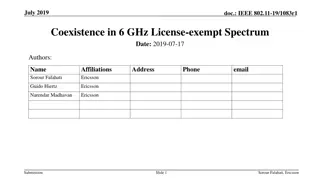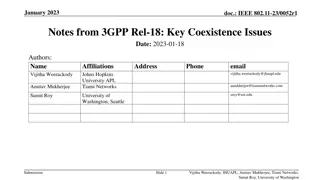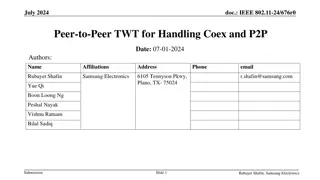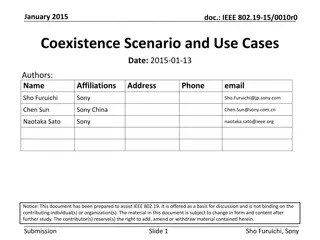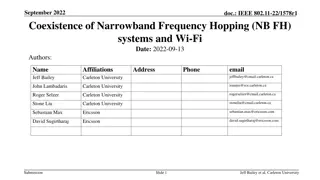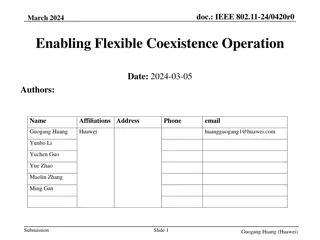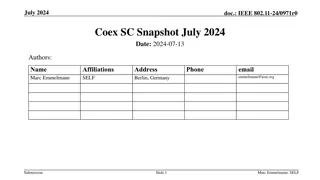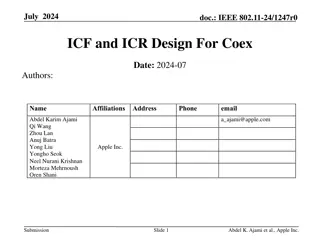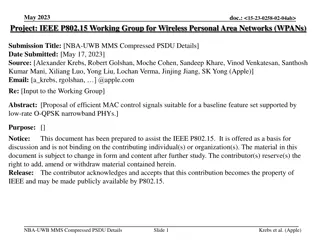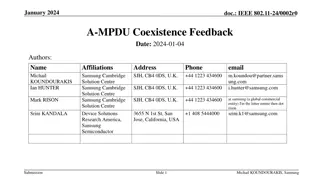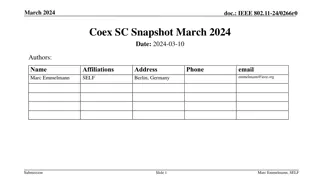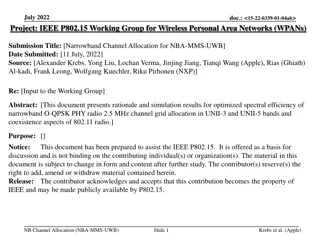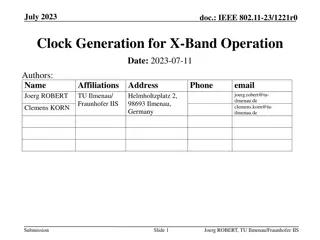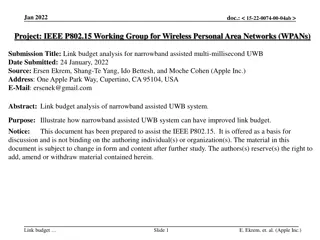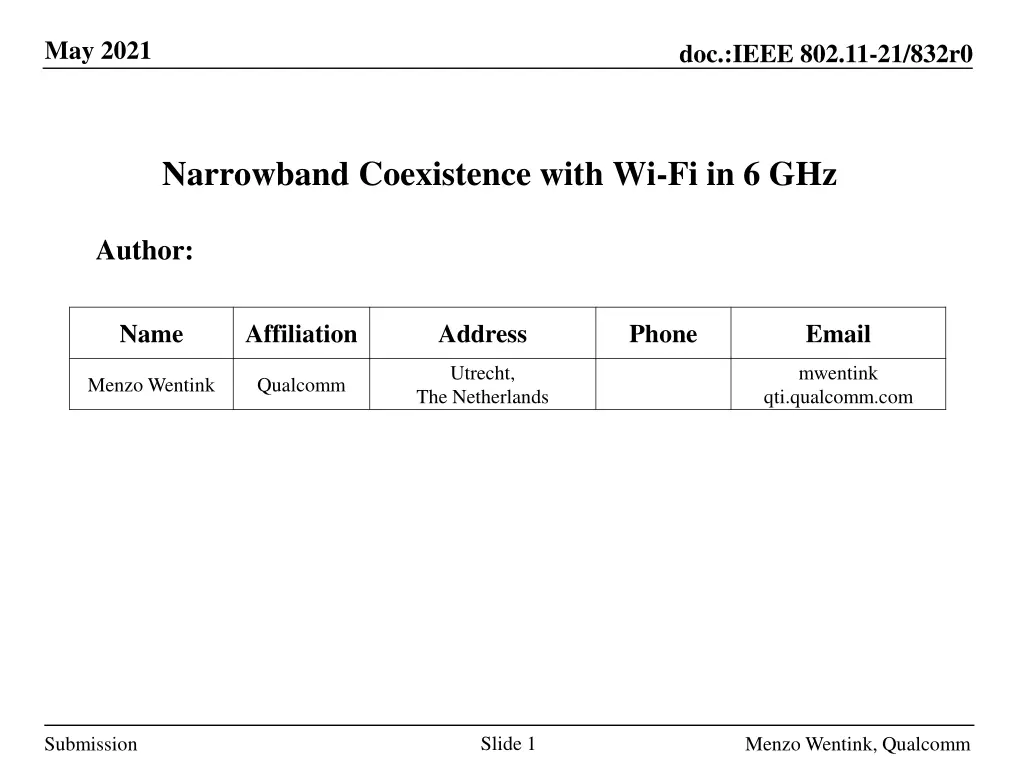
Narrowband Coexistence Analysis Between Wi-Fi and Bluetooth in 6 GHz Band
This document analyzes the coexistence between Wi-Fi and Bluetooth in the 6 GHz band using narrowband frequency hopping. It discusses interference measurements, test setups, simulation settings, and the impact of Bluetooth interference levels on Wi-Fi throughput. The study highlights how Wi-Fi performance degrades with increasing Bluetooth interference levels, emphasizing the importance of coexistence mechanisms like Detect and Avoid (DAA) for mitigating interference.
Download Presentation

Please find below an Image/Link to download the presentation.
The content on the website is provided AS IS for your information and personal use only. It may not be sold, licensed, or shared on other websites without obtaining consent from the author. If you encounter any issues during the download, it is possible that the publisher has removed the file from their server.
You are allowed to download the files provided on this website for personal or commercial use, subject to the condition that they are used lawfully. All files are the property of their respective owners.
The content on the website is provided AS IS for your information and personal use only. It may not be sold, licensed, or shared on other websites without obtaining consent from the author.
E N D
Presentation Transcript
May 2021 doc.:IEEE 802.11-21/832r0 Narrowband Coexistence with Wi-Fi in 6 GHz Author: Name Affiliation Address Phone Email Utrecht, mwentink qti.qualcomm.com Menzo Wentink Qualcomm The Netherlands Slide 1 Submission Menzo Wentink, Qualcomm
May 2021 doc.:IEEE 802.11-21/832r0 Introduction Narrowband (NB) frequency hopping has been proposed in the 6 GHz band, per document BRAN(21)109e003r1 (EN 303 687 NB Inputs) this document proposes to use the NB channel access rules from the 2.4 GHz band in EN 300 328 these rules include Detect and Avoid (DAA) Document BRAN(21)109e003r1 (EN 303 687 NB Inputs) presents interference measurements between BT and Wi-Fi This submission analyzes coexistence between BT and Wi-Fi, on the same test setup as used in BRAN(21)109e003r1 Slide 2 Submission Menzo Wentink, Qualcomm
May 2021 doc.:IEEE 802.11-21/832r0 Wi-Fi - BT Test Setup Wifi link 80 MHz, 1ss 433.3 Mbps max PHY rate (VHT MCS9, NSS = 1, 400 ns GI) 23 dB 23 dB AP 12 dB STA 3 dBm 58 dB Variable Attenuation A dB (0 110 dB) 47 + A dB 47 + A dB 47 + A dB 47 + A dB 12 dB BT1 12 dB BT2 10 dBm no attenuation no attenuation BT link 79 MHz, 79 hops 1 MHz hop width 625 s dwell time 3 Mbps max PHY rate (EDR 8-DPSK) Slide 3 Submission Menzo Wentink, Qualcomm
May 2021 doc.:IEEE 802.11-21/832r0 Simulation settings Wi-Fi link 80 MHz channel width, VHT (11ac), Nss = 1 Maximum throughput about 410 Mbps (MCS9, 400 ns GI, 80 MHz, 433.3 Mbps) Receive bitrate based on receive SINR and MCS sensitivities for MCS0 MCS9 BT link 79 hops, 1 MHz hop width, 79 MHz hopping bandwidth 625 s dwell time, 600 s Tx, 25 s switch time, 96% duty cycle 3 Mbps max bitrate based on EDR 8-DPSK BT is on the same channel as the Wi-Fi link (co-channel interference) DAA uses a 40 ms COT, when enabled 100 pps Wi-Fi link (BT replacement link) 80 MHz channel width, VHT (11ac), Nss = 1 3 Mbps throughput AC_VO access parameters Slide 4 Submission Menzo Wentink, Qualcomm
May 2021 Wi-Fi throughput as a function of the BT interference level (BT does not use DAA) doc.:IEEE 802.11-21/832r0 Wifi Throughput (Mbps) 500 450 400 the Wi-Fi throughput degrades significantly with increasing BT interference 350 Throughput (Mbps) 300 250 200 150 100 50 the residual Wi-Fi throughput is very low 0 -90 -80 -70 -60 -50 -40 BT Interference Level (dBm) Slide 5 Submission Menzo Wentink, Qualcomm
May 2021 Wi-Fi throughput as a function of the BT interference level (BT uses DAA) doc.:IEEE 802.11-21/832r0 Wifi Throughput (Mbps) 500 450 400 with DAA, the Wi-Fi throughput also degrades significantly 350 Throughput (Mbps) 300 250 200 the residual Wi-Fi throughput is still very low, also when BT uses DAA 150 100 50 0 -90 -80 -70 -60 -50 -40 BT Interference Level (dBm) Slide 6 Submission Menzo Wentink, Qualcomm
May 2021 Wi-Fi throughput as a function of the BT interference level (BT uses 1 in 5 hops, 20% DC) doc.:IEEE 802.11-21/832r0 Wifi Throughput (Mbps) 500 450 400 the Wi-Fi thoughput degrades significantly, also when BT uses 1 out of every 5 hops (20% duty cycle) 350 Throughput (Mbps) 300 250 200 150 100 the residual Wi-Fi throughput is very low 50 0 -90 -80 -70 -60 -50 -40 BT Interference Level (dBm) Slide 7 Submission Menzo Wentink, Qualcomm
May 2021 Wi-Fi throughput as a function of the BT interference level (BT uses 20% of every hop) doc.:IEEE 802.11-21/832r0 Wifi Throughput (Mbps) 500 450 400 the Wi-Fi thoughput degrades significantly, also when BT uses 20% of every hop 350 Throughput (Mbps) 300 250 200 150 100 50 the residual Wi-Fi throughput is very low 0 -90 -80 -70 -60 -50 -40 BT Interference Level (dBm) Slide 8 Submission Menzo Wentink, Qualcomm
May 2021 doc.:IEEE 802.11-21/832r0 Wi-Fi latency as a function of the BT interference level (BT does not use DAA) Access Delay (ms) 1000 900 800 without DAA, the Wi-Fi peak latency becomes very high when BT interferes above -62 dBm 700 Access Delay (ms) 600 500 400 300 the latency peaks depend on the specific BT hopping schedule (assuming Wi-Fi can dynamically switch to 20 MHz channel width, otherwise the latency will be even higher) 200 100 0 -90 -80 -70 -60 -50 -40 BT Interference Level (dBm) Slide 9 Submission Menzo Wentink, Qualcomm
May 2021 doc.:IEEE 802.11-21/832r0 Wi-Fi latency as a function of the BT interference level (BT uses DAA) Access Delay (ms) 1000 900 800 with DAA, the Wi-Fi peak latency still becomes very high 700 Access Delay (ms) 600 500 400 300 the latency peaks depend on the specific BT hopping schedule (assuming Wi-Fi can dynamically switch to 20 MHz channel width, otherwise the latency will be even higher) 200 100 0 -90 -80 -70 -60 -50 -40 BT Interference Level (dBm) Slide 10 Submission Menzo Wentink, Qualcomm
May 2021 doc.:IEEE 802.11-21/832r0 Wi-Fi latency as a function of the BT interference level (BT uses 1 in 5 hops, 20% DC) Access Delay (ms) 1000 900 800 BT using 1 out of 5 hops (20% dutcy cycle) causes very high latency for Wi-Fi 700 Access Delay (ms) 600 500 400 300 the latency peaks depend on the specific BT hopping schedule (assuming Wi-Fi can dynamically switch to 20 MHz channel width, otherwise the latency will be even higher) 200 100 0 -90 -80 -70 -60 -50 -40 BT Interference Level (dBm) Slide 11 Submission Menzo Wentink, Qualcomm
May 2021 doc.:IEEE 802.11-21/832r0 Wi-Fi latency as a function of the BT interference level (BT uses 20% of every hop) Access Delay (ms) 1000 900 800 BT using 20% of every hop causes very high latency for Wi-Fi 700 Access Delay (ms) the latency is very high in this case, because the idle time inside the hops cause Wi-Fi to transmit, after which the next hop destructively interferes with it 600 500 400 300 the latency peaks depend on the specific BT hopping schedule (assuming Wi-Fi can dynamically switch to 20 MHz channel width, otherwise the latency will be even higher) 200 100 0 -90 -80 -70 -60 -50 -40 BT Interference Level (dBm) Slide 12 Submission Menzo Wentink, Qualcomm
May 2021 doc.:IEEE 802.11-21/832r0 DAA number of active hops as a function of time (BT at a high interference level, uses DAA) Number of Active Hops 80 with DAA, the number of active hops oscillates, which is very strange it takes 3 s before DAA first reacts to the Wi-Fi traffic 70 60 Number of Active Hops 50 40 simulation at high interference level 30 16 s period time between DAA CCAs: 3.16 s 20 maximum unavailability time: 15.8 s 10 after 10 s, DAA still did not detect Wi-Fi on 12 hops BT DAA COT: 40 ms 0 0 10 20 30 40 50 60 70 80 90 100 Time (s) Slide 13 Submission Menzo Wentink, Qualcomm
May 2021 doc.:IEEE 802.11-21/832r0 Wi-Fi throughput as a function of time (BT at a high interference level, uses DAA) Rx Bitrate (Mbps) 450 400 the Wi-Fi throughput oscillates in counter- phase with the number of active hops 350 300 Rx Bitrate (Mbps) 250 200 150 100 50 Red: BT throughput 0 0 10 20 30 40 50 60 70 80 90 100 Time (s) Slide 14 Submission Menzo Wentink, Qualcomm
May 2021 doc.:IEEE 802.11-21/832r0 Wi-Fi latency as a function of time (BT at a high interference level, uses DAA) Access Delay (s) 1 0.9 0.8 Wi-Fi can still experience very high latency when DAA is used 0.7 Access Delay (s) 0.6 0.5 0.4 0.3 0.2 0.1 Red: BT latency 0 0 10 20 30 40 50 60 70 80 90 100 Time (s) Slide 15 Submission Menzo Wentink, Qualcomm
May 2021 doc.:IEEE 802.11-21/832r0 Comparison between BT sharing and Wi-Fi sharing (Impact on main Wi-Fi link throughput) Throughput Comparison (Mbps) 500 for the red curve, the BT link was replaced with a 100 pps 3 Mbps Wi-Fi link 400 Wifi sharing Throughput (Mbps) 300 Full buffer (100 pps Wifi interference) 200 Full buffer (BT interference) 100 in this plot, Wi-Fi uses 4x4 sensitivity levels, causing the throughput degradation to set in at higher interference levels BT sharing 0 -80 -75 -70 -65 -60 -55 -50 -45 -40 -35 Interference level (dBm) Slide 16 Submission Menzo Wentink, Qualcomm
May 2021 doc.:IEEE 802.11-21/832r0 Comparison between BT sharing and Wi-Fi sharing (Impact on main Wi-Fi link latency) Latency Comparison (ms) 2000 1800 BT sharing 1600 1400 1200 Latency (ms) 1000 Full buffer (BT interference) 800 Full buffer (100 pps Wifi interference) 600 400 for the red curve, the BT link was replaced with a 100 pps 3 Mbps Wi-Fi link 200 Wifi sharing 0 -80 -75 -70 -65 -60 -55 -50 -45 -40 -35 Interference level (dBm) Slide 17 Submission Menzo Wentink, Qualcomm
May 2021 doc.:IEEE 802.11-21/832r0 Conclusions BT frequency hopping can cause major throughput and latency degradation at a Wi-Fi link also when BT uses a reduced duty cycle or Detect and Avoid (DAA) while Wi-Fi defers for BT, BT will not defer for Wi-Fi and step onto ongoing Wi-Fi transmissions, due to the absence of LBT these simulations do not consider the effect of out of band emissions, which may cause similar issues even when the BT link is not on the same channel as the Wi-Fi link these simulations also do not consider the effect of multiple BT links operating near a WiFi link, which will make things worse DAA shows an oscillation of active hops DAA may not have been designed for coexistence with Wi-Fi Slide 18 Submission Menzo Wentink, Qualcomm
May 2021 doc.:IEEE 802.11-21/832r0 Potential next steps / areas for further analysis Continue analysis of coexistence characteristics of NB proposals Evaluate impact of NB interference from adjacent / non-overlapping frequencies on Wi-Fi throughput and latency Evaluate impact of multiple NB links interfering with a Wi-Fi link Analyze potential impact of NB interference on high value 6 GHz use cases Explore protocol designs for improved NB coexistence Further study the impact of NB interference into a wideband Wi-Fi signal Other? Slide 19 Submission Menzo Wentink, Qualcomm



